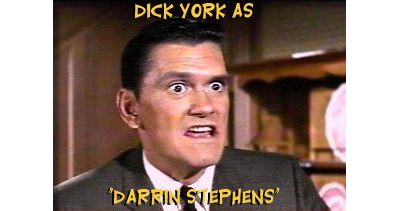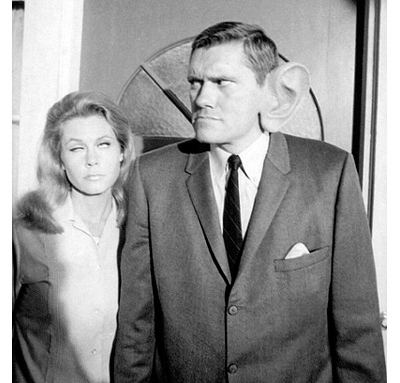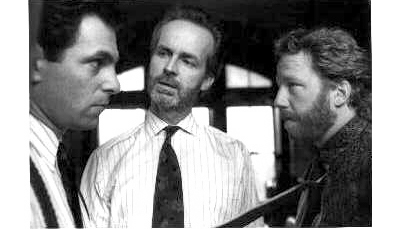There comes a time for many design students when classmates sit around the keg and reveal their true selves: i.e. the reason they decided to study design. This was The Tell.
My experience with The Tell painfully revealed how common I truly was; for I learned that several other classmates, male and female, had the exact same role model.

Yes. Darrin Stephens from the television show Bewitched.
Even though poor “Derwood’ was besot with a meddling mother-in-law, a mercenary boss and a nosy neighbor, there was something about his life… He was creative, he could work at home if he wanted, and his job seemed much cooler than any adult I knew.
And when it came time to pick a college, I suspect that having Darrin Stephens around helped my classmates’ and my parents understand our choices… kind of.
Our esteemed colleague Michael Bierut has postulated on the role Ayn Rand’s Howard Roark plays in our everyday client psychodramas and studio rantings. Sure, I’ll admit to a Roarkian delusion — but that’s the rationale after we have the job. Where’s the motivation? He would rather starve than compromise, he didn’t get along well with others and his lover Dominique Francon was well… complicated.
Nope. Darrin Stephens was my model: lovely wife, colorful relatives, well-stocked bar in the living room, and clients who bought the idea without too too much back-and-forth.

Another example how success comes from being a good listener.
A couple decades later, the show thirtysomething featured a couple other other other Rands: Michael Steadman (played by Ken Olin) and Elliot Weston (played by Timothy Busfield). Perhaps because I was already working in New York when the show premiered, I have my doubts that Michael and Elliot held the same effect on impressionable minds. While more ‘real’, they were also big babies. They stomped around the studio more, their creative blocks were so much more dramatic, and their personal lives seemed more difficult.
On the other hand, Darrin worked for McMann & Tate, an agency whose name carried more gravitas than the Michael and Elliot Company. Darrin’s clients were Captains of Industry — all in three-piece suits, demanding and decisive — while Michael and Elliot’s were just ordinary volk.

Michael Steadman (left) and Elliot Weston (right) with the evil head of the DAA agency, Miles Drentell (hmm… I wonder where THAT name came from)
If you Google “bewitched”, “advertising” and any variant spelling of “stevens”, then click around for a while, you’ll see quite a few testimonials similar to mine. Darrin was a blend of archetype, myth and daddy. He was a cipher for the upcoming information economy where one’s merit is based on their ideas. He was our role model. Perhaps you can call us… The Bewitched Generation.






The Other Other Other Rand
I actually had the misguided and dubious distinction of attending Ayn Rand lectures at the Nathaniel Branden Institute (NBI) in Manhattan during the sixties (when I was a teen). Why? My best friend's mom was a follower and dragged us young'ins along with her to raise our hippy consciousnesses.
Having grown up with socialist values, however, Ayn's Objectivism blather and individual ego �ber alles clap trap was a bit hard to swallow (even though I know lots of my classmates were seduced by the artistic genius in The Fountainhead (the book) - and also Patricia Neal's sculpted physique (in the movie).
Like Mark, I was more influenced by Dick York's portrayal of the hapless advertising guy (although he was lucky enough to have not only Elizabeth Montgomery as a bride, but all the be-witchly endowments that came with her), than Ayn Rand (she had a torrid and nasty affair with Mr. Branden, btw).
BUT there was another other other Rand for me. His name was Erik Nitsche, a somewhat unsung modern pioneer, though rarely unemployed. I've written at length about him in the upcoming Baseline (http://www.baselinemagazine.com/), but its worth noting here that he had many of the same kinds of jobs as Paul Rand in advertising, magazine, and corporate design (he even confided that he was offered the IBM job), but took different career paths. He also did not teach, but rather became an "author," as the packager of scores of books that were beautifully designed on the "Nitsche grid" and splendidly written and researched (they included popular histories of communications, transportation, music, etc.).
I know for many book designers he was indeed their RAND. His opus history of General Dynamics (for which he was design director for 10 years) was a masterpiece of cinematic pacing.
He was not Howard Roark nor Dick York, but he was a complete designer and a total inspiration.
On Dec.17.2004 at 08:17 AM